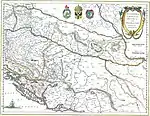Grand Duke of Bosnia
Grand Duke of Bosnia (Bosnian: Veliki Vojvoda Bosanski; Latin: Bosne supremus voivoda / Sicut supremus voivoda regni Bosniae)[1][2] was a court title in the Kingdom of Bosnia, bestowed by the King to highest military commanders, usually reserved for most influential and most capable among highest Bosnian nobility.[3][4][5][6] To interpret it as an office post rather than a court rank could be more accurate.[7][8]
Part of a series on the |
|---|
| History of Bosnia and Herzegovina |
 |
|
|
History
Unlike usage in Western Europe or Central Europe, as well as in various Slavic lands from Central to North-East Europe, where analogy between Grand Duke and Grand Prince was significant, with both titles corresponding to sovereign lower than King but higher than Duke, in Bosnia title Grand Duke corresponded more to Byzantine military title megas doux.[8][9]
Generally, Slavic word knez is often referred to ruler, sometimes analogous to King, thus veliki knez was more like High king than Grand duke.[10] In that sense, although like in rest of South Slavic neighboring states and among its nobility, in Bosnia also existed the title knez or veliki knez, nominally analogous to Prince and Grand Prince, it was in fact ranked as medium to major feudal landlord, with corresponding influence in the Bosnian Stanak (also Great Bosnian Rusag (Bosnian: "veliki bosanski rusag"), Whole of Bosnia (Bosnian: "sva Bosna")), which was institute of assembly of all Bosnian nobility, regardless of rank and status.[8]
However, in neighboring countries title Duke, in Slavic Vojvoda, also had military signification, but in that sense "Grand Duke" was specifically, even exclusively, Bosnian title.[7]
Accordingly, the title Grand Duke of Bosnia was explicitly given by Bosnian ruler, at the time Ban, King or Queen respectively, to his/her highest-ranking military commanders.[10] As such, it was an actually more like an office rather than a court rank, although it was also a grade in the court order of precedence, and was often held by one individual at the time, rarely two.[7]
Title-holders
- Hrana Vuković (?-1380)
- Hrvoje Vukčić Hrvatinić (1380–1388)
- Vlatko Vuković (1388–1392)
- Sandalj Hranić (1392–1435)
- Stjepan Vukčić Kosača (1435–1448)
- Radislav Pavlović (1441-?)
Further reading
- "Veliki vojvoda bosanski Sandalj Hranić Kosača", Esad Kurtović, publisher Institut za istoriju Sarajevo, 2009
- "Viteske svecanosti u Budimu 1412. godine i ucesce bosanskih predstavnika (Festivities held in Buda in 1412 and the participation of Bosnian magnates)", Emir O. Filipović, Spomenica akademika Marka Šunjića (1927-1998), Filozofski fakultet u Sarajevu, 2010
References
- Sulejmanagić, Amer (30 November 2012). "Novac Hrvoja Vukčića Hrvatinića" [Coins minted by Duke Hrvoja Vukčića Hrvatinića] (html, pdf). Numizmatičke Vijesti (in Serbo-Croatian). 54 (65): 54–85. ISSN 0546-9422. Retrieved 8 May 2020.
- Vatroslav Jagić; Lajos Thalloczy; Franz Wickhoff (1899). "Missale Glagoliticum Hervoiae ducis Spalatensis". archive.org (in Latin). Retrieved 10 May 2020.
- Miller, William (2014). Essays on the Latin Orient. Cambridge University Press. p. 481. ISBN 9781107455535. Retrieved 16 February 2019.
- Preveden, Francis Ralph (1962). A history of the Croatian people from their arrival on the shores of the Adriatic to the present day: with some account of the Gothic, Roman, Greek, Illyrian, and prehistoric periods of the ancient Illyricum and Pannonia. Philosophical Library. pp. 98, 99, 100. Retrieved 16 February 2019.
- Zlatar, Zdenko (2007). The Poetics of Slavdom: The Mythopoeic Foundations of Yugoslavia. Peter Lang. p. 544. ISBN 9780820481357. Retrieved 16 February 2019.
- Cvetković, Branislav (19 December 2014). "The Header to the Ten Commandments in the Hval Codex: a Contribution to the Semantics of Medieval Illumination". Ars Adriatica (in Croatian and English). hrcak.srce.hr. pp. 155–172. Retrieved 16 February 2019.
- Kurtović, Esad (2009). Veliki vojvoda bosanski Sandalj Hranić Kosača (PDF) (in Bosnian) (Historijske monografije; knj. 4 ed.). Institut za istoriju Sarajevo. ISBN 978-9958-649-01-1. Archived from the original (.pdf) on 5 March 2016. Retrieved 10 January 2016.
- Fine, John Van Antwerp (1994). The Late Medieval Balkans: A Critical Survey from the Late Twelfth Century to the Ottoman Conquest. University of Michigan Press.
- Filipović, Emir O. (2010). "Viteske svecanosti u Budimu 1412. godine i ucesce bosanskih predstavnika (Festivities held in Buda in 1412 and the participation of Bosnian magnates)" (.pdf/.html). Spomenica Akademika Marka Šunjića (1927-1998), Filozofski Fakultet U Sarajevu (in Bosnian and English). Filozofski fakultet u Sarajevu. Retrieved 10 January 2016.
- Malcolm, Noel (2002). Bosnia: A Short History. Pan Books, Pan Macmillan of Macmillan Publishers Ltd. ISBN 978-0814755617.